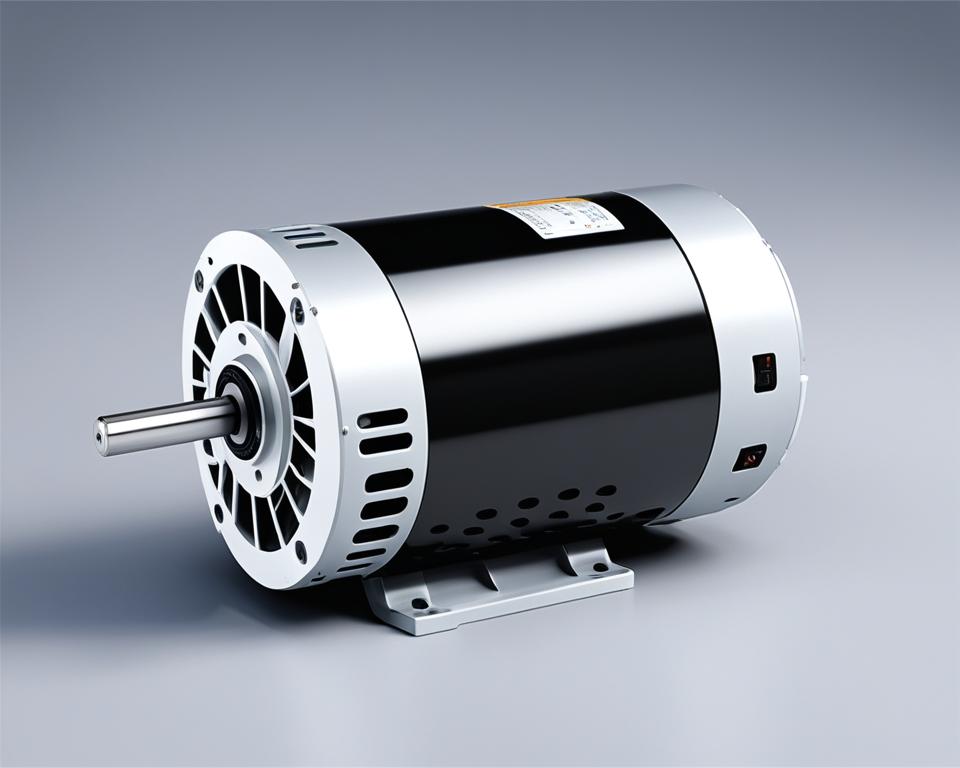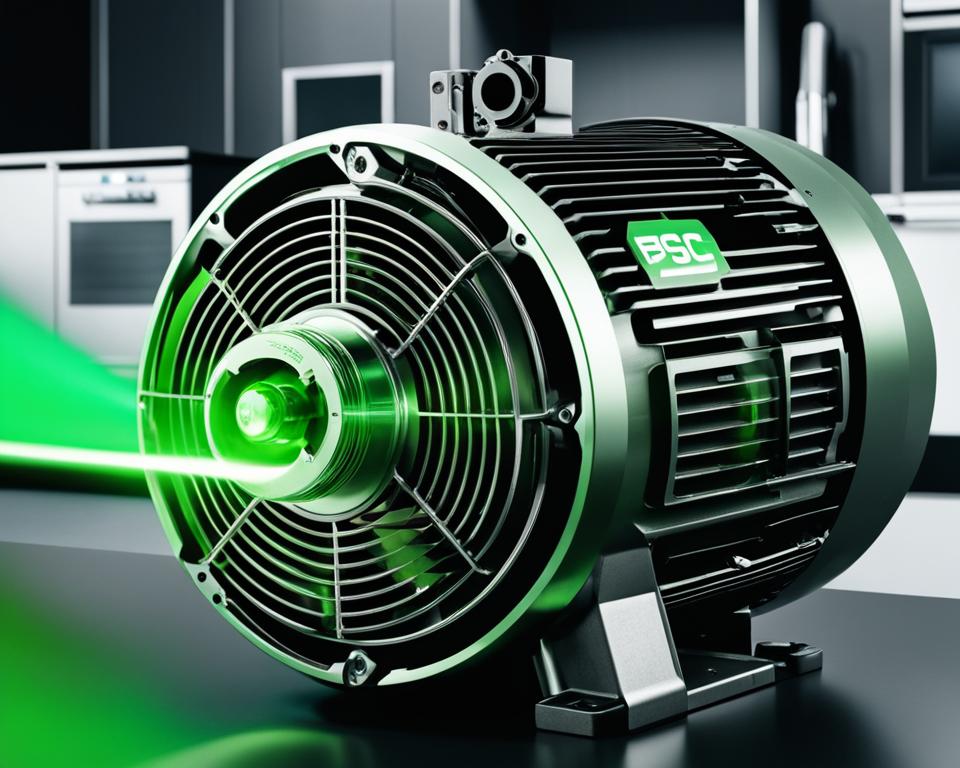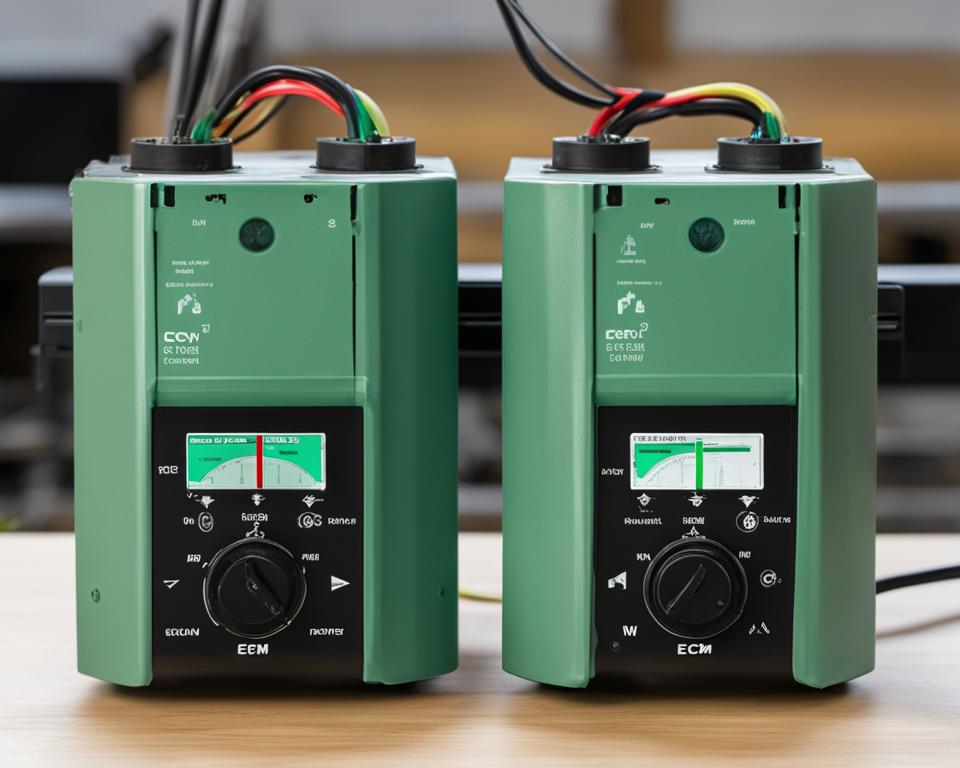Are you considering the purchase of a new motor for your HVAC system? If so, it’s essential to understand the key differences between Electronically Commutated Motors (ECM) and Permanent Split Capacitor (PSC) motors. These two types of motors vary in their energy efficiency, which can have a significant impact on your electric bills and overall system performance.
ECM motors are permanent magnet motors, while PSC motors are induction motors. The main difference lies in their efficiency levels. ECM motors maintain a consistent efficiency of 80% across all speeds, whereas a 6-pole PSC motor operates at 60% efficiency on high speed, 50% efficiency on medium speed, and 40% efficiency on low speed.
The higher efficiency of ECM motors means that they convert a greater amount of electrical power into useful work, resulting in lower energy consumption and reduced utility costs. Additionally, ECM motors can be operated at much lower speeds compared to PSC motors, leading to significant energy savings.
Key Takeaways:
- ECM motors are more energy-efficient than PSC motors, maintaining an 80% efficiency at all speeds.
- PSC motors operate at varying efficiency levels based on speed, ranging from 40% to 60%.
- The higher efficiency of ECM motors leads to lower energy consumption and reduced electric bills.
- ECM motors can be operated at lower speeds, resulting in additional energy savings.
- ECM motors offer greater control and precision compared to PSC motors, improving overall system performance.
ECM Motor Features and Advantages
ECM motors, also known as Electronically Commutated Motors, possess a range of remarkable features and advantages that set them apart from their counterparts, such as PSC motors. These cutting-edge motors are controlled electronically by a microprocessor, enabling precise speed control and optimization.
One of the key advantages of ECM motors is their exceptional electrical efficiency. They can maintain high efficiency across a wide range of operating speeds, resulting in significant energy savings. This efficiency advantage is particularly notable when compared to PSC motors, as ECM motors operate at a consistent 80% efficiency regardless of speed, surpassing the 60-40% efficiency range of PSC motors.
Moreover, ECM motors are available in various sizes, making them highly versatile for different applications. They are commonly used in direct drive applications, where their efficiency and precision control shine the brightest. This versatility extends to compatibility with both new and older equipment, ensuring ease of installation and integration into existing systems.
One standout feature of ECM motors is their quiet operation. These motors produce minimal noise during operation, enhancing the comfort and ambiance of any environment. In contrast, PSC motors can be relatively louder, causing potential disturbances in quiet spaces.
ECM motors also boast a wider operating range compared to PSC motors, allowing for greater flexibility and adaptability in HVAC systems. They can be seamlessly integrated into various systems and provide consistent performance and efficiency across their expanded operating range.
“ECM motors are the future of energy-efficient motor technology. With precise speed control, higher electrical efficiency, and quieter operation, they outperform PSC motors in every aspect.”
Advantages of ECM Motors:
- Electronic control for precise speed control
- Higher electrical efficiency across a wide range of operating speeds
- Versatility in different sizes and direct drive applications
- Quiet operation, promoting a serene environment
- Wider operating range for enhanced adaptability
ECM motors have revolutionized the industry with their advanced features and unparalleled advantages over traditional PSC motors. Their efficiency, precision, and adaptability make them an excellent choice for achieving superior energy savings and overall performance in HVAC systems.
| ECM Motor Features and Advantages |
|---|
| Precise speed control |
| High electrical efficiency across a wide range of operating speeds |
| Versatile in different sizes and direct drive applications |
| Quiet operation |
| Wider operating range for enhanced adaptability |

PSC Motor Specifications and Benefits
PSC (Permanent Split Capacitor) motors are commonly used in air handlers, air conditioners, and refrigeration applications. These motors are designed with two sets of windings and a permanent capacitor to create current lag, which helps in achieving the desired motor characteristics.
PSC motors have an efficiency range of 55% to 65% when operating at full load. However, they are less efficient when lightly loaded. Due to their design, PSC motors are often oversized to provide flexibility in various applications, resulting in lower efficiency. This oversizing can lead to excess heat generation, which adds to the building’s cooling load and impacts overall energy consumption.
Benefits of PSC Motors
PSC motors offer certain advantages in specific situations. Some benefits of PSC motors include:
- Cost-effective: PSC motors are generally more affordable compared to ECM (Electronically Commutated Motor) motors, making them a popular choice in HVAC systems where cost is a primary concern.
- Simple design: PSC motors are relatively simple in construction, making them reliable and easy to maintain.
- Long lifespan: PSC motors have a long lifespan and can operate effectively for many years with proper maintenance.
Despite these benefits, it’s important to consider the lower efficiency and potential energy consumption of PSC motors in light of the overall objectives and requirements of the HVAC system.
| Efficiency | Cost | Application | |
|---|---|---|---|
| PSC Motors | 55% to 65% (at full load) | Cost-effective | Air handlers, air conditioners, refrigeration |
| ECM Motors | Up to 80% (at all speeds) | Higher initial cost | Air handlers, furnaces, heat pumps |

Energy Saving Opportunity with ECM Motors
By choosing high-efficiency ECM motors, you can unlock significant energy-saving benefits for your HVAC system. ECM motors are specifically designed to reduce energy consumption and maximize efficiency, making them an ideal choice for both residential and commercial applications. Compared to traditional PSC motors, ECM motors can decrease energy usage by up to 75%. This translates into substantial cost savings and a more sustainable approach to energy consumption.
One of the key advantages of ECM motors is their superior energy efficiency. These motors are engineered to deliver optimal performance at all speeds, ensuring consistent energy savings throughout their operation. Their advanced technology and electronic control system enable precise and unlimited airflow selection, making it easier to maintain the desired comfort levels in your space while minimizing power consumption.

Moreover, ECM motors offer several other benefits that contribute to energy savings. These motors require less maintenance compared to PSC motors, which translates into cost savings and reduced downtime. Additionally, ECM motors are designed to be more durable and reliable, ensuring long-term efficiency and reliability. They are also not prone to overheating, reducing the risk of motor failure and potential damage to the entire HVAC system.
In the context of HVAC applications, ECM motors offer superior performance and energy efficiency. They are capable of maintaining airflow during changes in system static pressure, providing consistent and efficient ventilation throughout the entire building. This ensures optimal air quality and thermal comfort while minimizing energy waste.
It’s worth noting that investing in energy-saving ECM motors may also make you eligible for energy rebates and incentives, as they contribute to green building initiatives. These programs not only incentivize the use of energy-efficient technologies but also help reduce the environmental impact of your building’s operations.
To summarize, ECM motors present a valuable opportunity for energy savings and increased efficiency. Their advanced technology, precise control, and high-performance capabilities make them an excellent choice for HVAC systems. By choosing ECM motors, you can significantly reduce energy consumption, lower operational costs, and contribute to a more sustainable future.
ECM Motor Installation and Compatibility
Installing ECM motors in furnaces and air handlers, both newer and older models, is a viable option for optimizing energy efficiency and performance. While they prove to be cost-effective for newer equipment, it is important to assess the longevity of older equipment before considering an investment in ECM motor retrofits.
When replacing PSC motors with ECM motors, it is crucial to ensure compatibility in terms of horsepower and physical fit. This ensures a smooth transition and maximizes the benefits of upgrading to ECM technology.
ECM motors provide a direct replacement option for X13 OEM motors, making the transition even easier for those seeking to upgrade from traditional induction motors. Moreover, ECM motors offer a wider operating range, allowing for more flexibility in various applications.
ECM Motor Installation
When installing ECM motors, it is essential to follow the manufacturer’s guidelines and instructions. Here are a few key steps to consider:
- Disconnect power to the system before beginning the installation process.
- Remove the old motor and disconnect any wiring connections.
- Install the ECM motor by aligning it properly and securing it using appropriate mounting hardware.
- Connect the necessary wiring, ensuring proper connections and following the provided wiring diagram.
- Complete the installation by reassembling the system and restoring power.
ECM Motor Compatibility
ECM motors are compatible with various HVAC equipment, including:
| Equipment | Compatibility |
|---|---|
| Furnaces | Compatible with most newer and older models |
| Air Handlers | Compatible with a wide range of air handler units |
| Heat Pumps | Compatible with heat pumps designed for ECM technology |
| Air Conditioning Units | With proper specifications, ECM motors can be retrofitted in air conditioning units |
It is recommended to consult with a professional HVAC technician or manufacturer to confirm compatibility with specific equipment models.
Customer Testimonial
“I recently replaced my old PSC motor with an ECM motor, and the difference is remarkable. Not only am I experiencing significant energy savings, but the system operates much quieter and more efficiently. It was a worthwhile investment!”
– Sarah Thompson, HVAC System Owner
Real-life Experiences and Testimonials
Many users have experienced remarkable energy savings and cost reductions after installing ECM motors. The feedback and testimonials from satisfied customers speak volumes about the advantages and benefits of choosing ECM motors for their HVAC systems.
“I can’t believe the difference the ECM motor has made in my energy bills. I used to dread my monthly electricity costs, but since the installation, I’ve seen a significant reduction in consumption. It’s amazing how much you can save!” – Sarah W.
Several users have reported energy consumption reductions of 30% to 40% after upgrading to ECM motors. These substantial savings translate into hundreds of dollars saved annually. Not only do ECM motors help the environment by reducing energy waste, but they also lead to significant cost savings for homeowners and businesses alike.
The Mars Azure Digi motor stands out among the popular choices for ECM motors. Customers love its exceptional efficiency, quiet operation, and ease of installation. Whether it’s for residential or commercial use, the Mars Azure Digi motor has garnered positive reviews and recommendations for its excellent performance and energy-saving capabilities.
However, it’s essential to follow the manufacturer’s instructions carefully during the installation process. Proper installation ensures optimal performance and prevents any potential issues that may arise.
To highlight the real-life experiences and testimonials of satisfied customers, here is a table summarizing some of their experiences:
| Customer | Experience |
|---|---|
| Sarah W. | 30% reduction in energy consumption resulting in hundreds of dollars in savings |
| John D. | Noticeably lower electric bills and improved energy efficiency |
| Emily S. | Quiet and smooth operation with no noticeable noise or vibration |
| Michael T. | Easy installation process with clear instructions |
These testimonials highlight the positive impact of ECM motors on energy savings, comfort, and overall satisfaction. By listening to real-life experiences, potential customers can gain valuable insights into the benefits of ECM motors and make informed decisions for their HVAC systems.
Let’s now explore the key factors to consider when evaluating and selecting ECM and PSC motors for your HVAC system.
Evaluating ECM and PSC Motors for Your HVAC System
When it comes to choosing between ECM and PSC motors for your HVAC system, there are several factors to consider to make an informed decision. Evaluating these factors will help you determine the most suitable motor for your specific needs.
Energy Efficiency
One of the key factors to consider is energy efficiency. ECM motors offer higher efficiency compared to PSC motors. Their advanced technology allows for precise speed control and consistent efficiency across a wide range of operating speeds. On the other hand, PSC motors may be more cost-effective in certain applications but have lower efficiency, particularly at lower speeds.
Cost
Cost is another important consideration when evaluating ECM and PSC motors. ECM motors tend to have a higher upfront cost compared to PSC motors. However, it’s crucial to assess the long-term savings potential of ECM motors due to their energy efficiency and reduced power consumption. Additionally, consider any potential rebates or incentives that may be available for installing ECM motors.
Compatibility and Desired Features
Before making a decision, it’s essential to assess the compatibility of ECM and PSC motors with your existing HVAC system. Evaluate whether your current equipment can accommodate the motor’s specifications and wiring requirements. Additionally, consider any specific features or functionalities you may require, such as variable speed control or noise reduction.
Here is a table summarizing the key considerations when evaluating ECM and PSC motors:
| Factors | ECM Motors | PSC Motors |
|---|---|---|
| Energy Efficiency | Higher efficiency and precise speed control | Lower efficiency, particularly at lower speeds |
| Cost | Higher upfront cost, potential long-term savings | Lower upfront cost |
| Compatibility | May require assessment and retrofitting | May require assessment and retrofitting |
| Desired Features | Precise speed control, quieter operation | Certain cost-effective applications |
By carefully evaluating the energy efficiency, cost, compatibility, and desired features, you can make an informed decision between ECM and PSC motors for your HVAC system.
Keep in mind that the specific needs of your HVAC system and your priorities will ultimately guide your decision. Consult with an HVAC professional to determine the best motor option for your specific requirements.
Conclusion
After comparing ECM motors and PSC motors, it is clear that ECM motors offer significant advantages in terms of energy efficiency and performance. Their superior control, lower power consumption, and quieter operation make them an ideal choice for those seeking long-term energy savings. Although ECM motors may come at a higher cost, the benefits and potential cost savings over time make them a worthwhile investment, especially for newer equipment.
However, it is important to consider the cost-effectiveness and expected lifespan of the equipment when considering retrofits or replacement of older systems. While ECM motors may be the ideal choice for certain scenarios, PSC motors may still be a more cost-effective solution for some applications. It ultimately depends on individual needs, priorities, and budget considerations.
In conclusion, when it comes to choosing between ECM and PSC motors, it is crucial to evaluate the specific requirements of your HVAC system and weigh the benefits against the cost. ECM motors offer higher efficiency, precise control, and quieter operation, making them a compelling option. Nevertheless, each situation is unique, and it is important to make an informed decision based on your individual circumstances and goals.
FAQ
What is the difference between an ECM and a PSC motor?
An ECM motor is a permanent magnet motor, while a PSC motor is an induction motor.
Which motor is more efficient, ECM or PSC?
ECM motors have a higher efficiency, operating at 80% efficiency at all speeds, while PSC motors have an efficiency range of 55% to 65% at full load.
What are the advantages of ECM motors?
ECM motors offer higher electrical efficiency, precise speed control, quieter operation, and a wider operating range compared to PSC motors.
What are the benefits of PSC motors?
PSC motors are commonly used in air handlers, air conditioners, and refrigeration applications. They are versatile and can operate at different speeds and capacities.
How much energy can be saved with ECM motors?
ECM motors can reduce energy consumption by up to 75% compared to PSC motors.
Can ECM motors be installed in older equipment?
ECM motors can be installed in newer and older furnaces and air handlers. However, the cost-effectiveness should be evaluated for older equipment that may be replaced soon.
What are some real-life experiences with ECM motors?
Many users have reported significant energy savings and cost reduction after installing ECM motors, with some seeing a 30% to 40% reduction in energy consumption.
How do I choose between ECM and PSC motors for my HVAC system?
When deciding between ECM and PSC motors, factors such as energy efficiency, cost, compatibility, and desired features should be considered.
Are ECM motors a worthwhile investment?
ECM motors offer higher efficiency, energy savings, and quieter operation, making them a worthwhile investment for newer equipment. However, the cost-effectiveness should be evaluated for older equipment.
